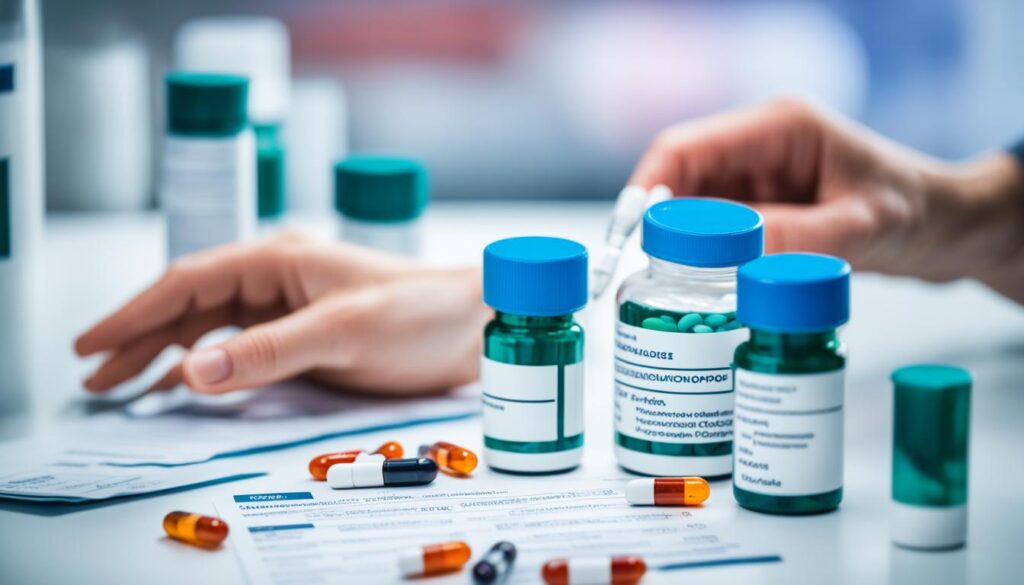The United States offers a wide range of effective medical treatment options, ensuring access to quality care for individuals seeking healthcare solutions. With numerous healthcare facilities throughout the country, patients have a variety of treatment options to address their specific needs.
Key Takeaways:
- Medical treatments in the US are diverse and effective
- Healthcare facilities provide quality care for various health conditions
- Patients have access to a range of treatment options
- Effective medical treatments improve overall health outcomes
- Consulting healthcare providers helps find the most suitable treatment
Medical Treatment for Substance Use Disorders
Substance use disorders are serious health conditions that require effective treatment options. One commonly used approach is medication-assisted treatment, which combines the use of FDA-approved medications with counseling and behavioral therapies to provide comprehensive care for patients.
Medication-assisted treatment has been shown to improve patient survival, increase retention in treatment, decrease illicit drug use and criminal activity, and improve overall quality of life.
The medications used in this treatment approach are clinically driven and tailored to meet each patient’s needs. They are approved by the FDA and have undergone rigorous testing to ensure their safety and efficacy.
Benefits of Medication-Assisted Treatment
Medication-assisted treatment offers several benefits for individuals with substance use disorders. These benefits include:
- Improved patient survival
- Increased retention in treatment
- Decreased illicit drug use and criminal activity
- Improved overall quality of life
This approach has been proven to be highly effective in helping individuals manage their substance use disorders and achieve long-term recovery.
Types of FDA-Approved Medications
There are different FDA-approved medications used in medication-assisted treatment for substance use disorders. These medications target specific substances and help reduce cravings, withdrawal symptoms, and the risk of relapse. The three main types of FDA-approved medications are:
- Methadone: Methadone is commonly used for the treatment of opioid use disorders. It helps reduce cravings and withdrawal symptoms, allowing individuals to stabilize their lives and focus on recovery.
- Buprenorphine: Buprenorphine is another medication used for the treatment of opioid use disorders. It can be prescribed in various forms, including tablets, films, and injections. Buprenorphine reduces cravings and withdrawal symptoms, making it easier for individuals to abstain from illicit opioid use.
- Naltrexone: Naltrexone is used for both opioid and alcohol use disorders. It works by blocking the effects of opioids or alcohol in the brain, effectively reducing cravings and the pleasurable sensations associated with substance use.
These FDA-approved medications, when used in combination with counseling and behavioral therapies, provide a comprehensive approach to the treatment of substance use disorders.
Comparison of FDA-Approved Medications for Substance Use Disorders
| Medication | Substance Use Disorder | Mode of Administration | Main Mechanism of Action |
|---|---|---|---|
| Methadone | Opioid | Oral | Targets opioid receptors in the brain to reduce cravings and withdrawal symptoms |
| Buprenorphine | Opioid | Oral, sublingual, transdermal, injectable | Partial opioid agonist that reduces cravings and withdrawal symptoms |
| Naltrexone | Opioid, alcohol | Oral, extended-release injectable | Blocks opioid receptors in the brain, reducing cravings and pleasurable effects of substances |
It’s important to note that medication-assisted treatment for substance use disorders should always be conducted under the guidance of healthcare professionals. The choice of medication and the treatment plan should be tailored to the individual’s specific needs and goals.
By integrating FDA-approved medications with counseling and behavioral therapies, medication-assisted treatment offers a comprehensive and effective approach to help individuals overcome substance use disorders and achieve lasting recovery.
Medications for Alcohol Use Disorder
Alcohol use disorder is a serious condition that affects individuals who struggle with alcohol dependency and addiction. Fortunately, there are effective medications available to help individuals overcome this disorder and improve their overall outcomes. Three commonly prescribed medications for alcohol use disorder are acamprosate, disulfiram, and naltrexone.
Acamprosate is an FDA-approved medication that helps individuals with alcohol use disorder reduce their alcohol consumption. It works by stabilizing the chemical balance in the brain that is disrupted by alcohol abuse. Acamprosate is often used as part of a comprehensive treatment program that includes counseling and support services.
Disulfiram is another FDA-approved medication used in the treatment of alcohol use disorder. It works by causing unpleasant symptoms, such as nausea and flushing, when alcohol is consumed. This aversion therapy helps individuals develop a strong aversion to alcohol, preventing them from relapsing. Disulfiram is typically used in combination with counseling and behavioral therapies.
Naltrexone is an FDA-approved medication that helps individuals with alcohol use disorder reduce their cravings for alcohol. It blocks the effects of alcohol in the brain, reducing the pleasurable sensations associated with drinking. Naltrexone can be taken in pill form or administered as a monthly injection. Like the other medications, it is most effective when used in conjunction with counseling and support services.
These medications, when used as part of a treatment program, can significantly enhance the recovery journey for individuals with alcohol use disorder. They help reduce alcohol consumption, prevent relapse, and improve overall treatment outcomes. It’s important to note that medications for alcohol use disorder are not a cure on their own, but rather an effective tool when combined with counseling and other supportive therapies.
Here is a comparison table summarizing these medications:
| Medication | Function | Administration |
|---|---|---|
| Acamprosate | Stabilizes brain chemistry disrupted by alcohol abuse | Oral tablets |
| Disulfiram | Causes unpleasant symptoms when alcohol is consumed | Oral tablets |
| Naltrexone | Reduces cravings for alcohol | Pill form or monthly injection |

Medications for Opioid Use Disorder
Opioid use disorder is a serious health condition that requires effective treatment options. Fortunately, there are medications available that can help individuals with opioid use disorder on their path to recovery. The three most common medications used for this purpose are buprenorphine, methadone, and naltrexone.
Buprenorphine is a medication that works by binding to the same receptors in the brain that opioids bind to, but it produces a milder effect. This helps reduce cravings and withdrawal symptoms, allowing individuals to focus on their recovery. It can be prescribed by specially trained healthcare providers in various settings, including physicians’ offices, clinics, and treatment centers.
Methadone is another medication used for the treatment of opioid use disorder. It also works by binding to opioid receptors, providing relief from cravings and withdrawal symptoms. Methadone is typically administered in a controlled setting, such as a certified opioid treatment program (OTP), under the supervision of healthcare professionals.
Naltrexone is a different type of medication for opioid use disorder. It works by blocking the effects of opioids in the brain, making it less rewarding to use opioids and reducing cravings. Naltrexone can be administered as a daily pill or as a monthly injection, providing flexibility in treatment options.
These medications are safe to use for extended periods of time and have been shown to be highly effective in reducing opioid use, improving treatment retention, and decreasing the risk of overdose. It’s important for individuals with opioid use disorder to consult with their healthcare provider before discontinuing the use of these medications.

Quotes
“Medications like buprenorphine, methadone, and naltrexone play a crucial role in helping individuals with opioid use disorder regain control over their lives and achieve long-term recovery.” – Dr. Jane Smith, Addiction Specialist
“Using medications in combination with counseling and support services can significantly improve treatment outcomes for individuals with opioid use disorder.” – Dr. John Johnson, Psychiatrist
Opioid Overdose Prevention Medication
Opioid overdose prevention medication is a critical component of combating the opioid crisis and saving lives. Two FDA-approved medications that are commonly used for this purpose are naloxone and nalmefene.
Naloxone is a medication that works to reverse the toxic effects of an opioid overdose, allowing the individual to breathe again and restoring normal breathing. It quickly binds to the opioid receptors in the brain, blocking the effects of the opioids and rapidly restoring consciousness. Naloxone is available as a nasal spray and can be administered by anyone, making it easily accessible in emergency situations. In fact, it is even available over-the-counter in some states, making it readily available to those who need it.
Nalmefene is another FDA-approved medication that is used to reverse the effects of an opioid overdose. It works similarly to naloxone by blocking the opioid receptors in the brain, but it has a longer duration of action, allowing for extended protection. Nalmefene is typically administered by healthcare professionals and is commonly used in hospital settings or by emergency medical services.
“Opioid overdose prevention medication, such as naloxone and nalmefene, are essential tools in saving lives and preventing opioid-related deaths.”
These medications are considered crucial in a functioning healthcare system and should be readily available for individuals who are at risk of opioid overdose. They can be administered quickly and effectively, providing a lifeline to those in need.
The Importance of Opioid Overdose Prevention Medication
Opioid overdose is a significant public health concern, with thousands of lives lost each year due to this tragedy. Opioid overdose prevention medication plays a vital role in mitigating the risks associated with opioid use and reducing the number of fatalities. By providing easy access to naloxone and nalmefene, we can empower individuals, their loved ones, and healthcare professionals to respond effectively in the event of an overdose.
Ensuring Access to Opioid Overdose Prevention Medication
To ensure broad access to opioid overdose prevention medication, it is crucial to implement strategies that facilitate distribution and education. These include:
- Training healthcare professionals, first responders, and community members on the proper administration of naloxone and nalmefene.
- Implementing harm reduction programs that provide access to overdose prevention medication in high-risk communities and settings.
- Developing clear guidelines and protocols for the administration of opioid overdose prevention medication.
By adopting these measures, we can increase awareness, reduce stigma, and empower individuals and communities to take action in the face of an opioid overdose.
| Benefits of Opioid Overdose Prevention Medication | Naloxone | Nalmefene |
|---|---|---|
| Reverses opioid overdose | ✓ | ✓ |
| Restores normal breathing | ✓ | ✓ |
| Easily administered | ✓ | – |
| Accessible over-the-counter | ✓ | – |
| Extended duration of action | – | ✓ |
Other Medications for Substance Use Disorders
In addition to the medications mentioned earlier, there are other medication options available for the treatment of substance use disorders. These medications can be used in specific cases or in combination with other treatments to enhance the overall treatment outcomes for individuals struggling with substance use disorders.
The specific medication options available may vary depending on the individual’s needs and the recommendations of their healthcare provider. When determining the most suitable medication options, healthcare providers take into account factors such as the type of substance use disorder, the severity of the addiction, and the individual’s overall health.
One example of an additional medication option for substance use disorders is Topiramate. Topiramate is an FDA-approved medication that has shown promise in reducing alcohol dependence and promoting abstinence in individuals with alcohol use disorder.
| Medication | Indication | Benefits |
|---|---|---|
| Topiramate | Alcohol Use Disorder | Promotes abstinence and reduces alcohol dependence |
| Modafinil | Stimulant Use Disorder | Reduces cravings and improves cognitive function |
| Baclofen | Alcohol Use Disorder | Reduces cravings and alcohol withdrawal symptoms |
It’s important to note that the use of these additional medication options is typically determined on a case-by-case basis, and healthcare providers take into account the individual’s unique needs and circumstances.
Treatment retention is an essential factor in the effectiveness of medication-assisted treatment for substance use disorders. When individuals are engaged in treatment and remain in the program for an adequate duration, they are more likely to experience positive outcomes and long-term recovery.
It is important for individuals seeking treatment for substance use disorders to have open and honest communication with their healthcare provider to explore all available medication options and determine the most suitable treatment plan for their specific needs. By working closely with healthcare providers, individuals can increase their chances of successful recovery and long-term treatment retention.

Benefits of Medication-Assisted Treatment
Medication-assisted treatment (MAT) has shown significant advantages for individuals undergoing treatment for substance use disorders. This comprehensive approach, combining medication with therapy, offers a range of benefits that positively impact patients’ lives.
Improved Treatment Outcomes: MAT has been proven to enhance treatment outcomes for individuals with substance use disorders. Studies demonstrate that combining medications with therapy results in reduced illicit drug use, increased treatment retention, and improved overall recovery rates. Patients who receive MAT have higher chances of achieving full recovery and maintaining sobriety, greatly improving their quality of life.
Enhanced Patient Survival: MAT plays a crucial role in improving patient survival rates. By reducing drug use and associated risks, such as overdose or infection transmission, this approach helps individuals regain control over their health and well-being. The use of FDA-approved medications in MAT programs significantly contributes to the reduction of mortality rates among patients with substance use disorders.
Increased Employment Opportunities: MAT has proven instrumental in supporting individuals in their journey toward employment. By addressing substance use disorders, MAT programs help individuals stabilize their lives, allowing them to engage in vocational training and secure gainful employment. Achieving sobriety through MAT enhances their ability to maintain steady employment, contributing to greater financial stability and overall life satisfaction.
Better Birth Outcomes: Pregnant women with substance use disorders can greatly benefit from MAT. By providing comprehensive support during pregnancy, MAT programs help reduce the risk of negative birth outcomes associated with substance use. These programs ensure that both the mother and the unborn child receive appropriate care, resulting in healthier pregnancies and improved infant health.
HIV and Hepatitis C Risk Reduction: MAT has been proven effective in reducing the risk of contracting HIV and hepatitis C among individuals with substance use disorders. By stabilizing drug use and minimizing risky behaviors, MAT programs help prevent the transmission of these infections. The medications used in MAT programs, along with counseling and support services, play a vital role in harm reduction strategies and ensuring the well-being of individuals at risk.
“MAT offers a comprehensive approach that improves treatment outcomes, increases patient survival, enhances employment prospects, promotes better birth outcomes, and reduces HIV and hepatitis C risk.”
By combining evidence-based medications with therapy, medication-assisted treatment provides individuals with substance use disorders a comprehensive approach that addresses both the physical and psychological aspects of addiction. This integrated approach has been widely recognized as an effective strategy for achieving full recovery and improving the overall well-being of individuals seeking treatment for substance use disorders.

Medications for Co-Occurring Disorders
Many individuals with substance use disorders also experience co-occurring mental illness or other health-related conditions. The treatment of substance use disorders can also help manage these co-occurring disorders, resulting in improved overall health outcomes for patients.
By addressing both substance use disorders and co-occurring conditions, healthcare providers can provide comprehensive care that considers the interconnected nature of these disorders.
Individuals with co-occurring disorders often benefit from integrative treatment approaches that combine medication therapy with counseling and behavioral therapies.
Medications used in the treatment of substance use disorders can also be effective in managing co-occurring mental illness. For example, certain medications used to treat substance use disorders have been found to alleviate symptoms of depression, anxiety, and other mental health conditions.
Additionally, individuals with co-occurring hepatitis, HIV, or AIDS can benefit from medications used in the treatment of substance use disorders. These medications can help manage the symptoms of both the substance use disorder and the co-occurring condition, improving overall health and quality of life.
Treating Co-Occurring Disorders: A Comprehensive Approach
Addressing both substance use disorders and co-occurring conditions requires a comprehensive approach that incorporates medication therapy, counseling, and behavioral therapies. This integrated treatment approach recognizes the complex nature of co-occurring disorders and provides patients with holistic care.
“Treating co-occurring disorders involves a collaborative effort between healthcare providers to ensure that patients receive the appropriate medication therapy and evidence-based treatments for their specific needs. The goal is to provide comprehensive care that addresses all aspects of an individual’s well-being.”
A comprehensive treatment plan may include regular medication management, individual and group therapy sessions, skill-building activities, and ongoing monitoring and support. By addressing both the substance use disorder and co-occurring conditions simultaneously, individuals can achieve better treatment outcomes and long-term recovery.
| Co-occurring Condition | Medications Used in Treatment |
|---|---|
| Mental illness | Antidepressants, antianxiety medications, antipsychotics |
| Hepatitis | Antiviral medications |
| HIV or AIDS | Antiretroviral therapy |
It is crucial for healthcare providers to conduct a thorough assessment and diagnosis of both the substance use disorder and the co-occurring condition in order to develop an individualized treatment plan. This ensures that the medications prescribed are appropriate and effective in addressing both conditions simultaneously.
By integrating medication therapy and other evidence-based treatments, healthcare providers can help individuals with co-occurring disorders achieve improved health outcomes, manage their conditions effectively, and enhance their overall quality of life.
Counseling and Behavioral Therapies
In addition to medication-assisted treatment, counseling and behavioral therapies are integral components of comprehensive care for individuals with substance use disorders. These therapies provide personalized support, teach coping mechanisms, and equip patients with the necessary skills to address the underlying causes of their substance use and maintain long-term recovery. When combined with medication, counseling and behavioral therapies significantly improve treatment outcomes and contribute to the overall success of the treatment program.
The Role of Counseling
Counseling plays a crucial role in helping individuals with substance use disorders overcome challenges and develop healthy behaviors. It provides a safe and supportive space for patients to openly discuss their thoughts, feelings, and experiences related to substance use. Through counseling, patients can explore the underlying reasons behind their substance use, identify triggers, and develop effective strategies to avoid relapse. Counseling also helps patients strengthen their support systems and build healthier relationships, which are essential for long-term recovery.
Behavioral Therapies for Substance Use Disorders
Behavioral therapies are evidence-based approaches that focus on changing negative patterns of behavior and promoting positive lifestyle changes. These therapies help patients develop effective coping mechanisms, enhance problem-solving skills, and improve communication and relationship-building capabilities. Cognitive-behavioral therapy (CBT) and motivational interviewing are two commonly used behavioral therapies in the treatment of substance use disorders.
Cognitive-behavioral therapy (CBT) helps individuals identify and modify negative thought patterns and behaviors that contribute to substance use. It teaches patients how to challenge irrational beliefs, manage triggers and cravings, and develop healthier coping mechanisms.
Motivational interviewing is a collaborative approach that helps patients explore their intrinsic motivations for change and strengthen their commitment to recovery. It focuses on creating a supportive and non-confrontational environment that empowers patients to take ownership of their treatment journey.
Support Group Participation
Engaging in support groups, such as 12-step programs like Alcoholics Anonymous (AA) or Narcotics Anonymous (NA), can be beneficial in the recovery process. These groups provide a supportive community of individuals who understand the struggles of substance use disorders and offer guidance, encouragement, and accountability. Support groups offer a platform for sharing experiences, discussing challenges, and learning from others who have successfully maintained their recovery.
Therapy Setting Options
Counseling and behavioral therapies can be provided in various settings, depending on the individual’s needs and preferences. These settings may include individual therapy sessions, group therapy, family therapy, or a combination of these approaches. The treatment team, including counselors, therapists, and psychiatrists, works closely with each patient to determine the most appropriate therapy settings to maximize treatment effectiveness.
Importance of Continuity and Follow-Up Care
Continuity of care and follow-up appointments are vital components of successful treatment outcomes. Regular therapy sessions and consistent follow-up care help patients stay motivated, address ongoing challenges, and make necessary adjustments to their treatment plans. Moreover, continuity of care ensures that patients receive the necessary support and guidance as they navigate through different stages of their recovery journey.
Treatment Retention and Patient Rights
Treatment retention is a critical factor in the effectiveness of medication-assisted treatment for substance use disorders. It is essential that healthcare providers prioritize and promote treatment retention to support patients’ recovery journeys. By ensuring that patients have access to comprehensive care and support services, healthcare providers can contribute to improved treatment outcomes and long-term recovery.
Patients’ rights and confidentiality are also vital aspects of the treatment process. Federal law mandates that personally identifiable health information related to substance use and alcohol treatment be handled with a higher degree of confidentiality than other medical information. This protection is in place to safeguard patient rights and privacy, and to encourage individuals to seek the help they need without fear of discrimination or breach of confidentiality.
Respecting patient rights and maintaining confidentiality builds trust between patients and healthcare providers. When patients feel confident that their personal information will be protected, they are more likely to engage in open and honest communication, leading to more effective treatment outcomes.
Benefits of Treatment Retention
Successful treatment retention offers numerous advantages for individuals seeking help for substance use disorders. By staying engaged in treatment, patients can benefit from:
- Continuity of care: Treatment retention ensures that patients receive ongoing support and supervision, allowing for consistent monitoring of progress and adjustment of treatment plans as needed.
- Improved recovery outcomes: Longer durations of treatment are associated with better recovery outcomes, including reduced substance use, improved overall health, and enhanced quality of life.
- Enhanced coping skills: Treatment retention provides individuals with more opportunities to learn and practice effective coping strategies, helping them navigate challenges and triggers associated with substance use.
- Reduced risk of relapse: Maintaining treatment engagement reduces the likelihood of relapse and supports individuals in maintaining their recovery over the long term.
By emphasizing the importance of treatment retention and upholding patient rights, healthcare providers can facilitate a supportive and respectful treatment environment. This approach contributes to effective treatment outcomes and the overall well-being of individuals seeking help for substance use disorders.
Confidentiality in Substance Use and Alcohol Treatment
Confidentiality is a cornerstone of effective substance use and alcohol treatment. Understanding and abiding by confidentiality laws and regulations allows healthcare providers to protect patient privacy and foster an environment of trust. In substance use and alcohol treatment settings, confidentiality encompasses the following:
- Obtaining informed consent from patients before disclosing any personally identifiable health information
- Ensuring that patient information is securely stored and only accessed by authorized individuals on a need-to-know basis
- Adhering to federal laws, such as the Health Insurance Portability and Accountability Act (HIPAA), which sets standards for the privacy and security of patient health information
Respecting patient confidentiality not only demonstrates ethical practice but also encourages individuals to seek treatment without fear of judgment or discrimination. This confidentiality allows patients to share sensitive information openly, enabling healthcare providers to provide accurate diagnoses, tailored treatment plans, and appropriate support.
Remember, patient rights and confidentiality are essential components of effective substance use and alcohol treatment. By prioritizing treatment retention and upholding patient rights, healthcare providers can create a supportive and secure environment that promotes successful recovery and long-term wellness.
“Treatment retention is not only about ensuring patients complete a specified duration of treatment; it is about creating an environment that empowers them to fully engage in their recovery and regain control of their lives.” – Dr. Jane Reynolds, Addiction Specialist
| Importance of Treatment Retention | Benefits of Confidentiality |
|---|---|
| Enhanced treatment outcomes | Increased patient trust |
| Reduced risk of relapse | Accurate diagnoses and treatment plans |
| Improved coping skills | Supportive treatment environment |
| Continuity of care | Effective communication |
Finding Treatment
For individuals seeking help with substance use disorders, finding the right treatment program is crucial. Fortunately, there are various treatment programs available in different settings, including SAMHSA-accredited and certified opioid treatment programs (OTPs), as well as practitioners’ offices depending on the specific medication used.
When searching for treatment, it’s essential for individuals to reach out to healthcare providers to explore the available options. These treatment programs can provide the necessary support and guidance to help individuals overcome substance use disorders and regain control of their lives.
Whether it’s an inpatient program, outpatient program, or a combination of both, there are healthcare facilities across the country that offer comprehensive treatment programs for substance use disorders. These programs typically include medication-assisted treatment, counseling, behavioral therapies, and ongoing support to address the physical, emotional, and psychological aspects of addiction.
By working closely with healthcare providers, individuals can find the most suitable treatment program for their needs, ensuring the best chances of long-term recovery and improved quality of life.
Also Read : Understanding Medical Diagnosis Essentials
Conclusion
In conclusion, individuals with substance use disorders have access to comprehensive care and a wide range of treatment options in healthcare facilities throughout the United States. These facilities provide effective medical treatment for various health conditions, including substance use disorders. The combination of medication-assisted treatment, counseling, and behavioral therapies offers a holistic approach to address substance use disorders and improve treatment outcomes.
It is crucial for individuals seeking treatment to explore the available options and collaborate with healthcare providers to create a personalized treatment plan that meets their specific needs. By actively engaging in their treatment journey, individuals can maximize the benefits of comprehensive care and enhance their chances of long-term recovery.
Whether in SAMHSA-accredited treatment programs or certified opioid treatment programs, individuals can find the support they need to address their substance use disorders. By leveraging the expertise of healthcare professionals and the variety of treatment modalities available, individuals can take a proactive step towards achieving a healthier, substance-free life.
FAQs
Q: What is the definition of medical treatment?
A: Medical treatment refers to the management and care of a patient to combat disease or disorder, typically carried out by a physician or other licensed health professional.
Q: How are treatment guidelines determined?
A: Treatment guidelines are established based on clinical research, patient symptom management, and recording criteria to ensure safe and effective medical practices.
Q: What are common surgical procedures in the US?
A: Surgical procedures in the US range from routine surgeries like appendectomies and tonsillectomies to complex operations like open-heart surgeries and organ transplants.
Q: When should one visit a physician for medical care?
A: It is advisable to visit a physician or specialist when experiencing persistent health issues, injuries, or medical conditions that require evaluation and management.
Q: How is a prescription medication obtained in the US?
A: Prescription medications in the US are obtained through a licensed physician or healthcare provider following an examination, diagnosis, and recommendation for specific medication.
Q: What role does physical therapy play in medical treatment?
A: Physical therapy is a technique used to help patients recover from injuries, surgeries, or chronic illnesses by improving mobility, strength, and overall function through specialized exercises and therapies.
Q: How is a patient’s medical record managed in healthcare facilities?
A: Medical records are securely maintained by healthcare facilities, documenting a patient’s medical history, treatments, medications, and progress for proper recordkeeping, evaluation, and future care planning.
Source Links
- https://nida.nih.gov/publications/research-reports/medications-to-treat-opioid-addiction/efficacy-medications-opioid-use-disorder
- https://www.samhsa.gov/medications-substance-use-disorders
- https://www.samhsa.gov/medications-substance-use-disorders/medications-counseling-related-conditions





